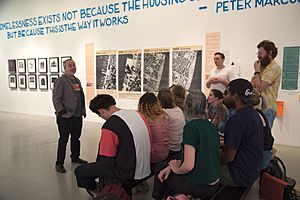Martha Rosler facts for kids
Quick facts for kids
Martha Rosler
|
|
|---|---|
| Born | 1943 (age 81–82) New York City, US
|
| Education | Brooklyn College, University of California, San Diego |
| Known for | Photography and photo text, Video art, Installation art, Performance art, conceptual art, writing |
|
Notable work
|
Semiotics of the Kitchen (1975); House Beautiful: Bringing the War Home (c. 1967-72; 2004-2008); The Bowery in two inadequate descriptive systems (1974/1975): If You Lived Here... (1989) |
Martha Rosler (born 1943) is an American artist famous for her work in many different styles. She uses photography, video, installations (large-scale artworks that you can often walk through), and performance to explore big ideas.
Rosler's art often looks at everyday life, especially from a woman's point of view. She is interested in how the media shows us the world, especially during times of war. She also explores topics like architecture, housing, and homelessness.
Contents
Early Life and Education
Martha Rosler was born in Brooklyn, New York, in 1943. She grew up in New York but spent many important years in California, from 1968 to 1980. She graduated from Brooklyn College in 1965 and later earned a master's degree from the University of California, San Diego in 1974. Since 1981, she has lived in New York City.
Career as an Artist and Teacher
Rosler's art and writing have had a big impact on the art world. For over 30 years, she was a professor at Rutgers University in New Jersey, where she taught photography and media. She has also taught at many other universities in the United States and Germany.
Her work has been shown in solo exhibitions at famous museums like the Whitney Museum of American Art in New York and the Institute of Contemporary Arts in London. She has also been part of major international art shows, including the Whitney Biennial, Documenta in Germany, and the Venice Biennale in Italy.
Besides making art, Rosler has written more than 16 books about her work, photography, and culture. Her essays have been published in many magazines and books around the world.
Famous Artworks
Rosler is known for creating art that makes people think. She often uses humor and surprise to challenge common ideas about society.
Semiotics of the Kitchen
One of Rosler's most famous works is a short video called Semiotics of the Kitchen (1975). In the video, she pretends to host a cooking show. She goes through kitchen tools from A to Z, but instead of using them normally, she demonstrates them in strange and aggressive ways.
The video is a funny but serious look at the roles women were often expected to fill. Rosler wanted to question if women could express themselves beyond these traditional roles.
House Beautiful: Bringing the War Home
This is a series of photomontages Rosler created between 1967 and 1972, during the Vietnam War. A photomontage is an artwork made by cutting and pasting different photos together. Rosler mixed pictures of beautiful, perfect American homes from magazines with shocking photos from the war.
By putting these two different worlds together, she showed a connection between life at home and the war happening far away. She wanted to make people think about how war affects everyone. She created a new series of these works in 2004 and 2008 based on the wars in Iraq and Afghanistan.
The Bowery in two inadequate descriptive systems
For this work (1974–75), Rosler took photos of shops on the Bowery, a street in New York City that was known for its homeless population. She then paired these photos with lists of words used to describe drunkenness.
By showing the photos and text side-by-side, Rosler argued that neither pictures nor words could fully explain a complex social problem like homelessness.
Major Projects and Exhibitions
Rosler is known for creating large, interactive projects that involve the public.
'If You Lived Here...'
In 1989, instead of a regular solo show, Rosler organized a huge project called "If You Lived Here...". She invited over 50 artists, architects, homeless people, and even schoolchildren to create art and have discussions about housing and city life. The project included three exhibitions and four public talks, all focused on the problems of homelessness and finding a place to live.
'Meta-Monumental Garage Sale'
In 2012, Rosler held a giant garage sale inside the famous Museum of Modern Art (MoMA) in New York. The sale included over 14,000 items from Rosler's own collection and things donated by the public. By putting a normal garage sale in a major museum, she made people think about how we decide what is valuable, whether it's a piece of art or an old household item.
'Martha Rosler Library'
Starting in 2005, Rosler turned her personal collection of over 7,500 books into a traveling library. The "Martha Rosler Library" was set up in galleries and schools in cities like New York, Paris, and Berlin. Visitors could read the books for free and even make photocopies. The project was a way to share knowledge and create a community space for learning.
Personal Life
Rosler's son is the graphic novelist Josh Neufeld. The two have worked together on several projects.
Awards and Recognition
Martha Rosler has received many awards for her work. Some of her most important honors include:
- 2005 Spectrum International Prize in Photography
- 2006 Oskar Kokoschka Prize, Austria's highest award for fine arts
- 2010 Lifetime Achievement Award from the Guggenheim Museum
- 2012 Distinguished Feminist Award from the College Art Association
- 2017 Lichtwark Prize from the city of Hamburg, Germany
See also
 In Spanish: Martha Rosler para niños
In Spanish: Martha Rosler para niños
- Feminist art movement in the United States



